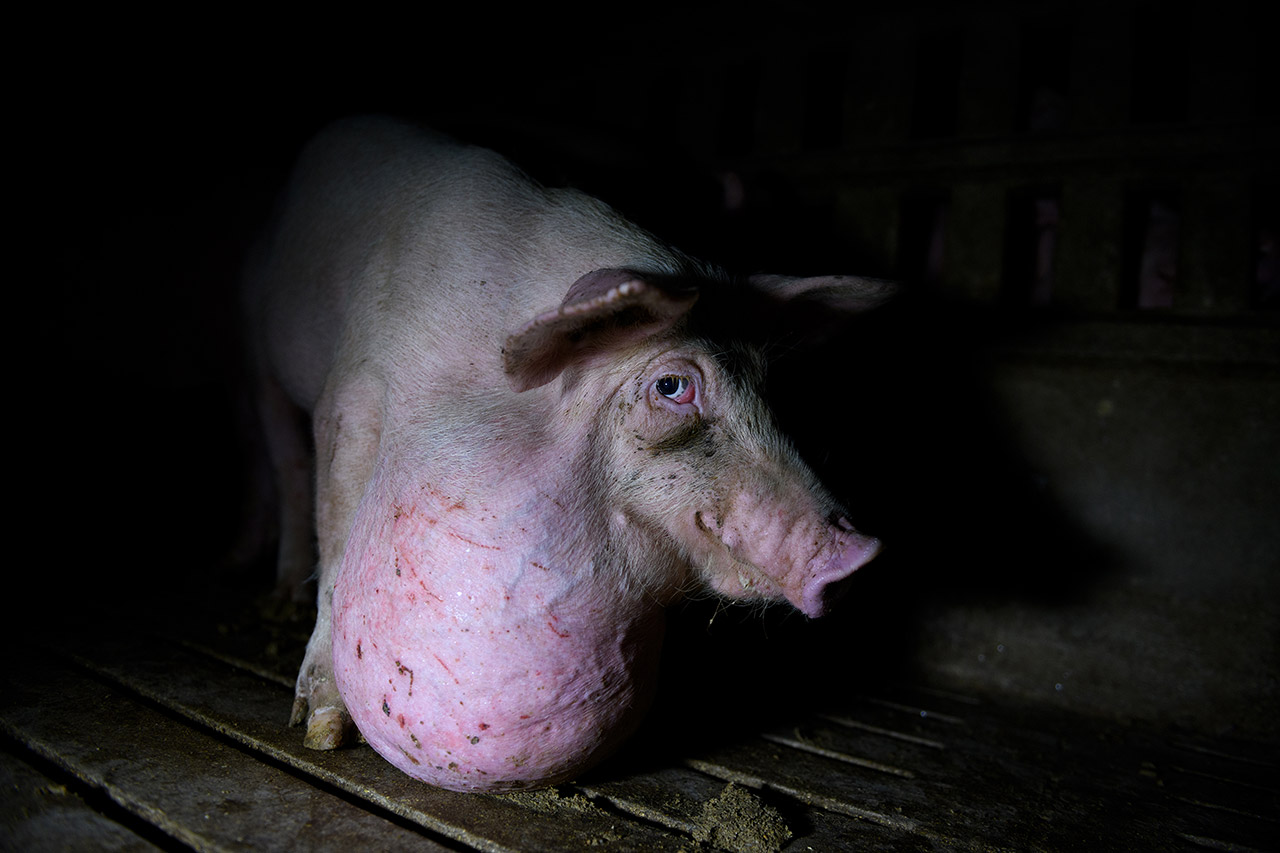

With a population of over 30 million individuals,1 the Spanish pig farming industry has established itself as the largest producer of live pigs within the European Union and, in 2020, is expected to exceed Germany, which had ranked first until now, in the number of animals sent to slaughter for the first time. In 2019, the largest pig processing slaughterhouse in Europe commenced operation in Binéfar, in the Huesca province of Spain. It is estimated that this plant alone will lead to the death of 160,000 pigs per week. Under the relentless pursuit of production, animals endure systemic suffering and institutional neglect.
Between 2019 and 2020, supported by a team of individuals who have chosen to remain anonymous, I carried out an investigation into 32 pig farms, located in Castilla y Leon, Aragon, and Castilla-La-Mancha. In these places, I discovered and documented the consequences of the structural violence that takes place within industrial animal agriculture.
The lack of veterinary oversight, the failure to meet basic legal welfare standards, and the abuses described in this report are not isolated incidents, but an inherent part of the industrial explotation and production of animals.
Images obtained during the investigation.
The images obtained from within the farms and slaughterhouses, thanks to undercover investigations, hidden cameras, or infiltration into the industries’ workforce reveal to the public an image which is very different from that which the meat industry chooses to show in its publicity campaigns. These images, which leave no doubt about the true practices of the industry, have managed to amplify a societal debate that meat producing corporations now cannot avoid.
Nevertheless, thanks to investment in costly propaganda efforts and its influence on both powerful public entities and the media, the industrial animal agriculture industry has sought to control the narrative, thus influencing public opinion and impeding our ability to exercise our right to information.
This power and influence has been made clear in a series of recent events:
In 2016, the industry was involved in a plot which sought to counter the negative narrative presented in a report which demonstrated the link between the consumption of meat and risk of cancer.2
In February of 2018, Minister of Agriculture, Fisheries, Food and the Environment, Isabel Garcia Tejerina, came out in defense of the meat production sector following a report which documented pigs with deformities and cannibalism in a farm supplying pigs to the meat products brand El Pozo.3, 4 Days later, in an attempt to confront the social turmoil caused by the images, the industry placed advertorials, which were designed to look like objective articles, in various mainstream media outlets. In March of the same year, the Superior Justice Tribunal of Castilla-La-Mancha condemned the local government and the meat production supplier, Incarlopsa – the main meat supplier to supermarket chain, Mercadona – for covering up failures to meet animal welfare standards in the company’s pig slaughterhouse.5
More recently, in July 2020, the «Let’s Talk About Pork from Europe» campaign was launched. According to the campaign’s press pack, it was designed to challenge the supposed false claims which have been levelled at the pig farming sector.6 The campaign, financed to the tune of more than 6 million euros ($7 million USD, £5.4 million GBP) by the European Union, will last for three years and is being coordinated by four powerful industry lobby groups: Organización Interprofesional Agroalimentaria del Porcino de Capa Blanca, l'Interprofession nationale porcino, Aligrupo y Grupalto.7
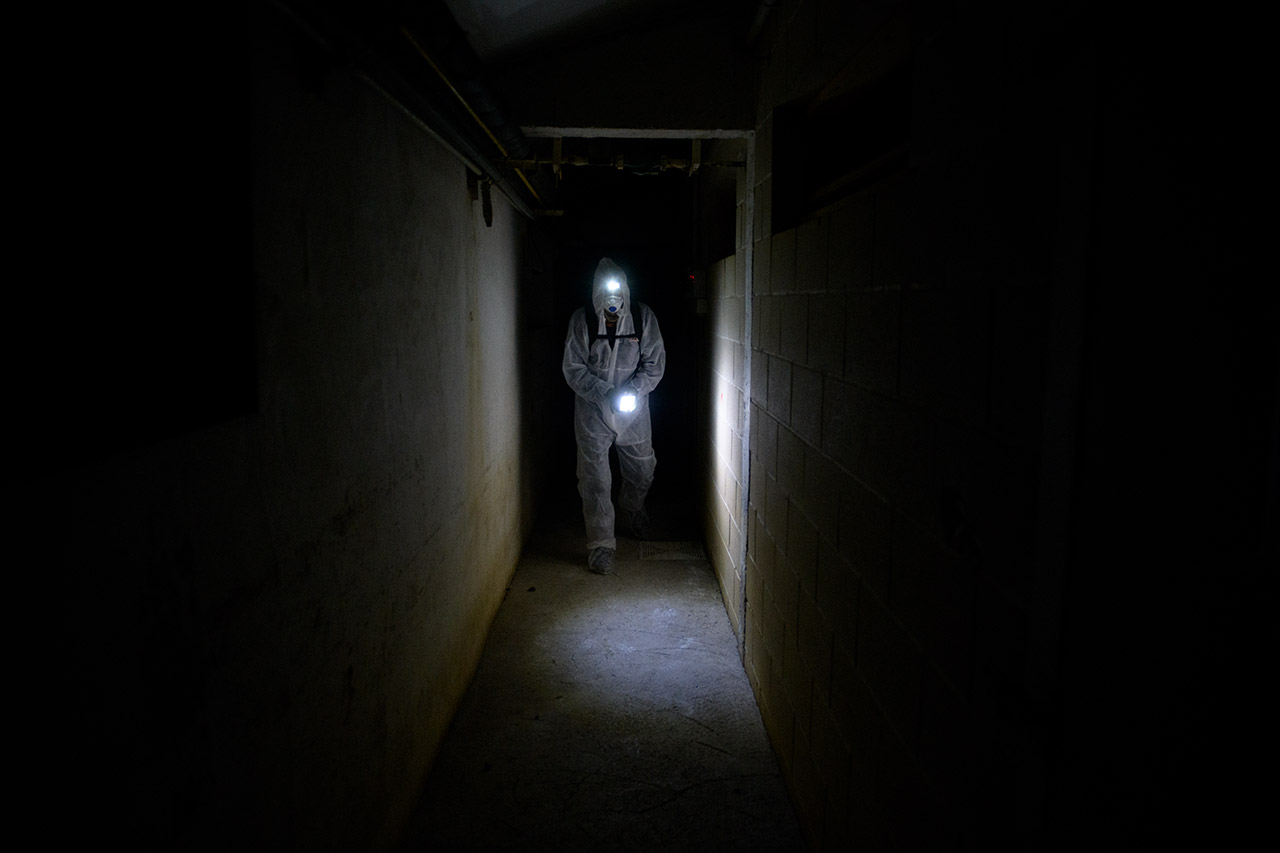
A member of the investigation team inspects the maternity area in a pig farm. Aragón, 2019.
In 2019, the Department of Agriculture, Farming, Fisheries and Food of the Generalitat of Catalunya threatened fines of up to €100,000 euros ($117,000 USD, £90,200 GBP) for anyone who gained unauthorized access to farms. The announcement of these measures arose from pressure from the industry following mass occupations of farms by animal rights activist.8, 9 The Generalitat accused the protesters of breaking animal welfare laws and defended the measures as a means to guarantee compliance with the law. However, in the absence of protests, the apparent concern for compliance with animal welfare laws does not appear to be of interest to the same authorities. In 2013, of 22,616 farms located in Catalunya, only 1,825 were inspected.10 Furthermore the images obtained by the occupations of the farms revealed non-compliance with the law on the part of the farms that would otherwise not have come to light. The only thing that the measures implemented achieve is to guarantee the impunity of the animal agriculture industry. In place of increasing control and improving transparency, the authorities instead chose to protect the industry and punish those who spoke out against its abuses of animals.
In the United States, the industry has operated for years under the same principles. The powerful meat lobbies have succeeded in introducing «gagging» (known colloquially as «Ag Gag») laws which prohibit undercover filming inside of farms.11, 12 These laws, which were explicitly designed to protect the large meat production corporations,13, 14, 15 have also now been implemented in other countries, including Canada and Australia.16, 17, 18, 19 Civil rights organizations, those which defend freedom of the press, human rights and consumer rights, farm workers unions, ecological organizations, and animal rights advocates have warned that these laws compromise freedom of expression, the right to information, animal welfare, workers’ rights, and food security and safety.20
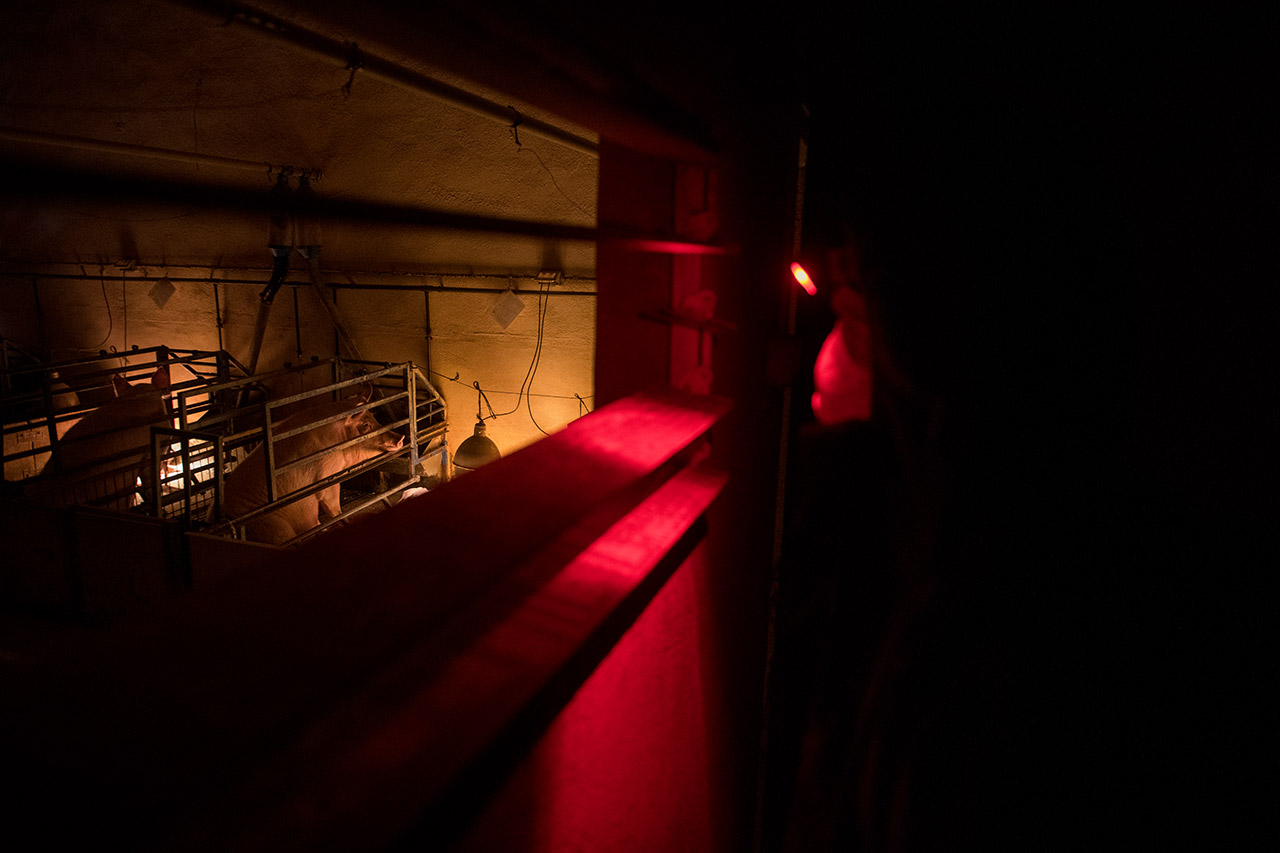
Maternity room where pigs give birth and feed their young. Castilla y León, 2020.
In recent years, the growth of exports of both pork and its derivatives has resulted in the Spanish pork industry becoming the largest in the European Union.21 In addition, with a turnover of more than €15,000 million euro ($17,500 million USD, £13,500 million GBP),22 the industry is the largest producer in the Spanish farming sector, representing 14% of the final agricultural product and 39% of livestock production.23
The population of pigs in Spain is the largest in the whole European Union1 and the third largest globally.24 The figure, which at the beginning of 2020 was 31,828,141,25 was obtained by calculating the number of live pigs in existence at a given time of year rather than, as official statistics report, the number of pigs slaughtered each year. The Spanish pork industry produces the most pigs in its farms in all the European Union.
Spain is second only to Germany when it comes to animals sent to slaughter (52,982,310 in 2019) and in the tons of meat produced (4,641,160 in 2019).26 This apparent anomaly between production and slaughter is due to the fact that Germany imports more animals for slaughter from other EU countries (information received from the General Directorate of Agricultural Productions and Markets in May 2020).
Furthermore, these figures do not include animals that are killed on the farms themselves for economic or other reasons, or those who do not survive the conditions on the farms. In the farrowing phase alone, casualties can exceed 20% of litters.27 This means that millions of pigs die each year before reaching the slaughterhouse.
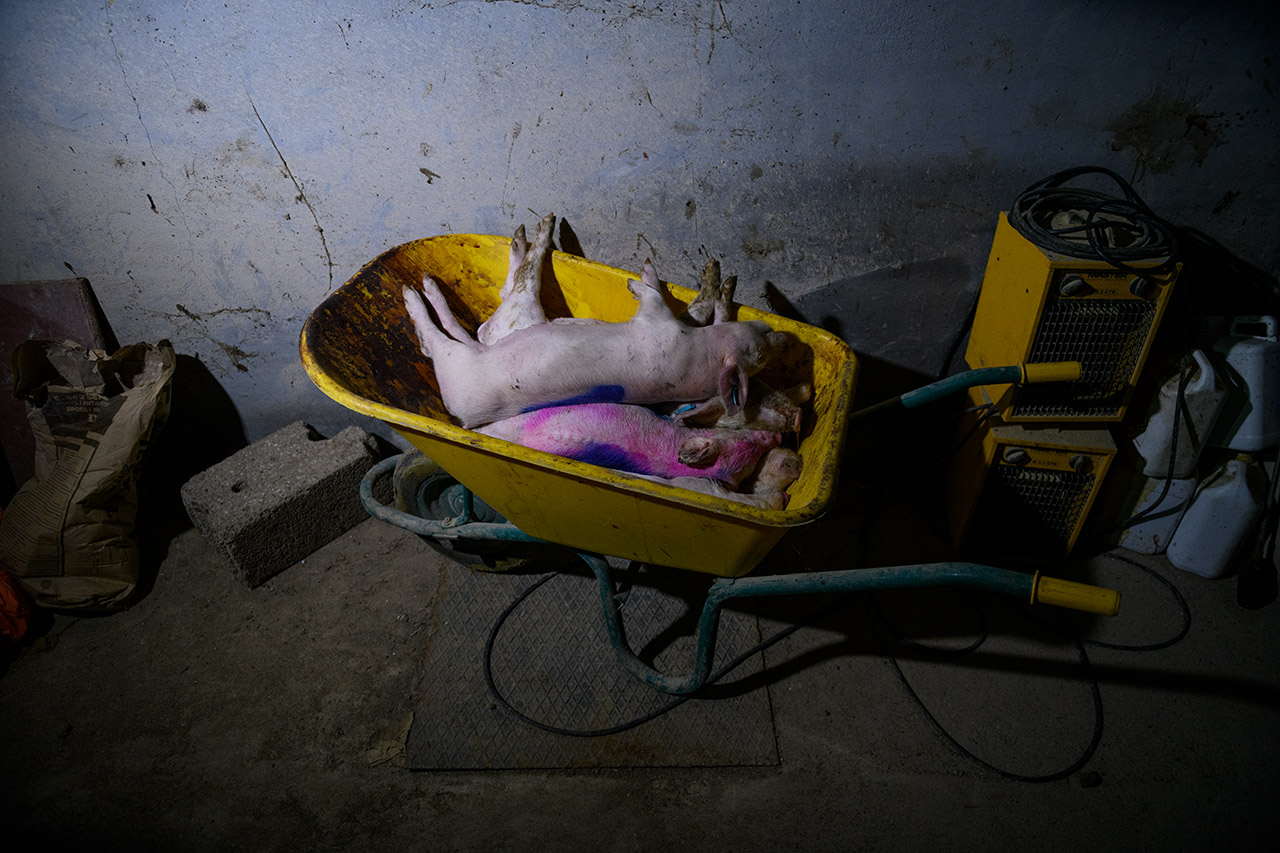
In the farrowing phase alone, casualties can exceed 20% of litters. (BDporc, 2019). Aragón, 2019.
Other data that helps to explain the development of the sector and to predict the direction in which it is headed relates to the evolution of the number of farms. Despite the fact that the number has decreased significantly (from 218,110 in 1999 to 87,540 in 2020),25, 28 farms have increased their capacity and now send 15 million more pigs to slaughter than they did two decades ago. According to the latest report from the Spanish Pig Reference Data Bank (BDPorc), the number of sows present in the farms included in its database has multiplied by four.27 This increase in production comes from factors such as technological innovation, genetic selection and farms with much higher capacity, which are now capable of housing a greater number of animals.
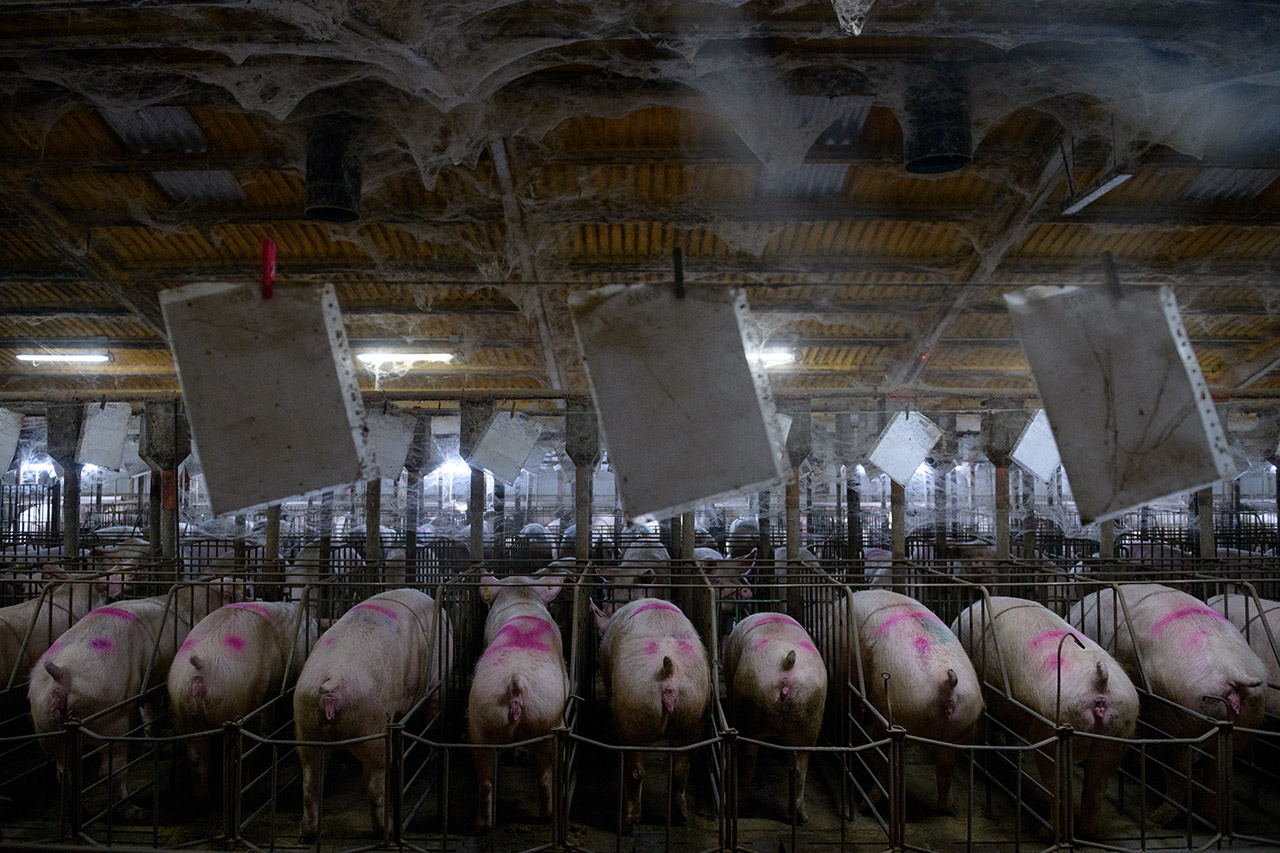
Gestation area. In Spain and the great majority of the EU territory the law allows keeping the sows in crates for single individuals during the first four weeks of pregnancy. Aragón, 2019.
More than 95% of the pork consumed in Spain comes from intensive farming systems.29 The farms can be closed cycle and contain all phases of production (gestation, maternity and fattening) in one or more geographically close locations or may be dedicated to covering only one of the phases. In the latter situation, the pigs destined for fattening are later transported by trucks to the fattening farm.
All farms operate under similar standards and are governed by the same regulations. Regardless of their size or their phased structure, the quality of life of the pigs is compromised in all of them; whether they are huge mega-farms or small family-run facilities. In their sheds, pigs exploited for meat production are housed on concrete floors in overcrowded and unsanitary conditions, and females selected for their reproductive capacity spend part of their lives trapped in iron cages, known as «gestation crates» and «farrowing crates». Confinement prevents the natural behavior of pigs. The inability to meet their innate needs and carry out their natural behaviors severely compromises their welfare. The frustration of their interests and needs can also lead to numerous physical health problems.30
Unlike other species, pigs lack sweat glands and their ability to dissipate heat is very limited. If they have the right conditions, they look for cool places, streams and puddles to take mud baths or rest. However, on intensive breeding farms the temperatures can be very high —something common in hot months of the year— and given the impossibility of accessing a place to cool off, they have no choice but to wallow in their own excrement.31
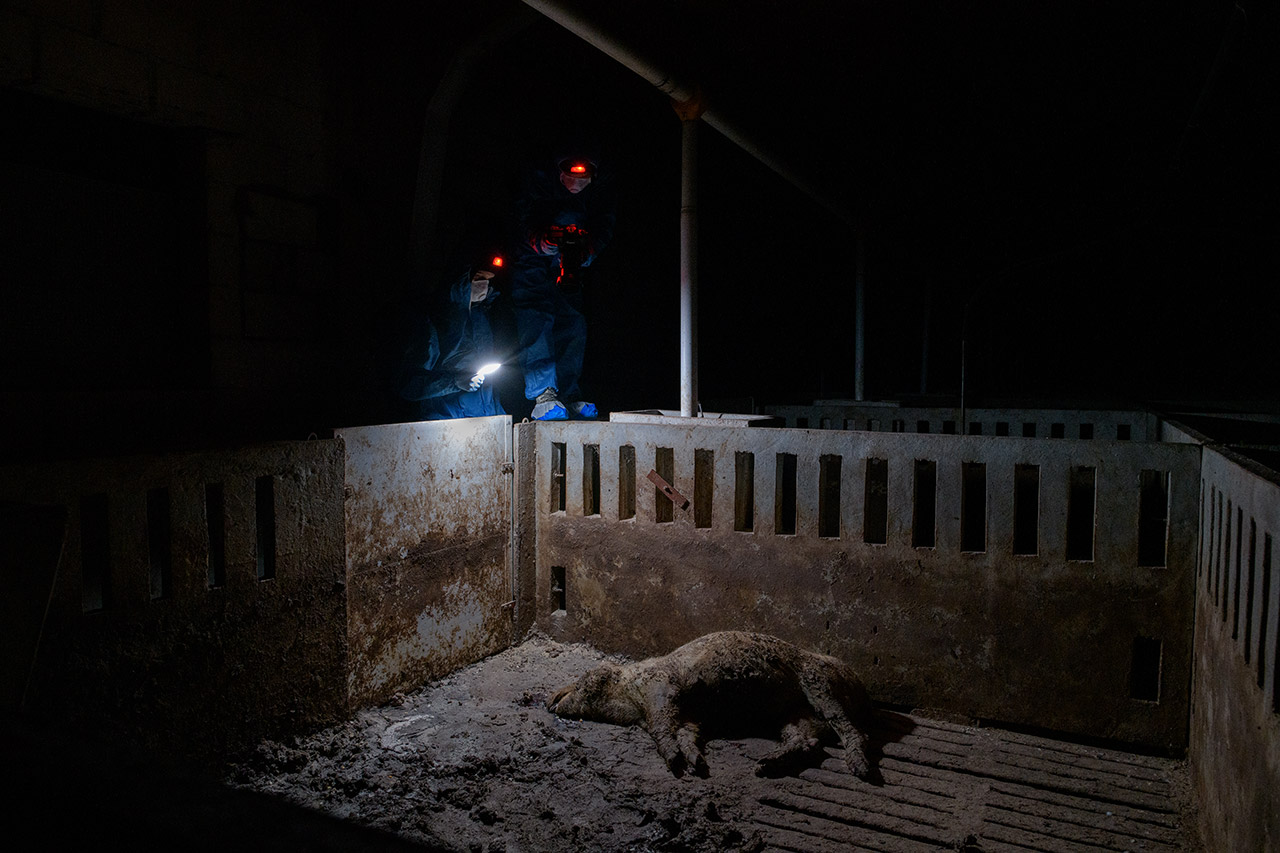
Fattening shed where we find scenes of cannibalism, corpses in a state of decomposition and remains of bones. Castilla La Mancha, 2020.
Even the air inside the pig sheds is unhealthy. The accumulation of dust combined with the humidity and vapors produced by the feces and urine of the animals generates a harmful atmosphere which can affect the health of both the pigs themselves and farm workers.30, 32, 33
Many pigs succumb to the horrendous living conditions and die on the farm. Their bodies are often not removed by farm workers and they can end up being eaten by other pigs, or by cats and rodents. During this investigation we found animals in states of severe suffering —trembling and convulsing, seriously injured or with respiratory problems—. Corpses were found in varying states of decomposition or having been partially consumed in the farrowing, transitional and fattening areas. Some had been there for days or even weeks.
The industry invests millions of euros in propaganda —some using public funds— in order to project an image of its work which bears little to no resemblance to reality. The confinement systems of the factory farm impede the physical and psychological well-being of the animals, seriously affect their health and compromise their quality of life. In addition, animal welfare inspections are scarce and the pig protection regulations that exist are not always complied with, nor are they fit for purpose.
The farms are made up of different areas that meet the productive needs of each phase. In order to maximize efficiency, many of them have high levels of sophistication and monitoring, mainly in the most critical phases of the process, that is, during labor and forced weaning. The extent to which technological resources are available varies from one farm to another.
During the course of this investigation, we were able to document each phase of the exploitation process; however, it has not been possible to obtain images of some specific handling and management practices. In addition to the farms which we have accessed, I sought permission from others to document the practices such as castration, tail docking, teeth cutting and insemination. In every instance, the request was denied.
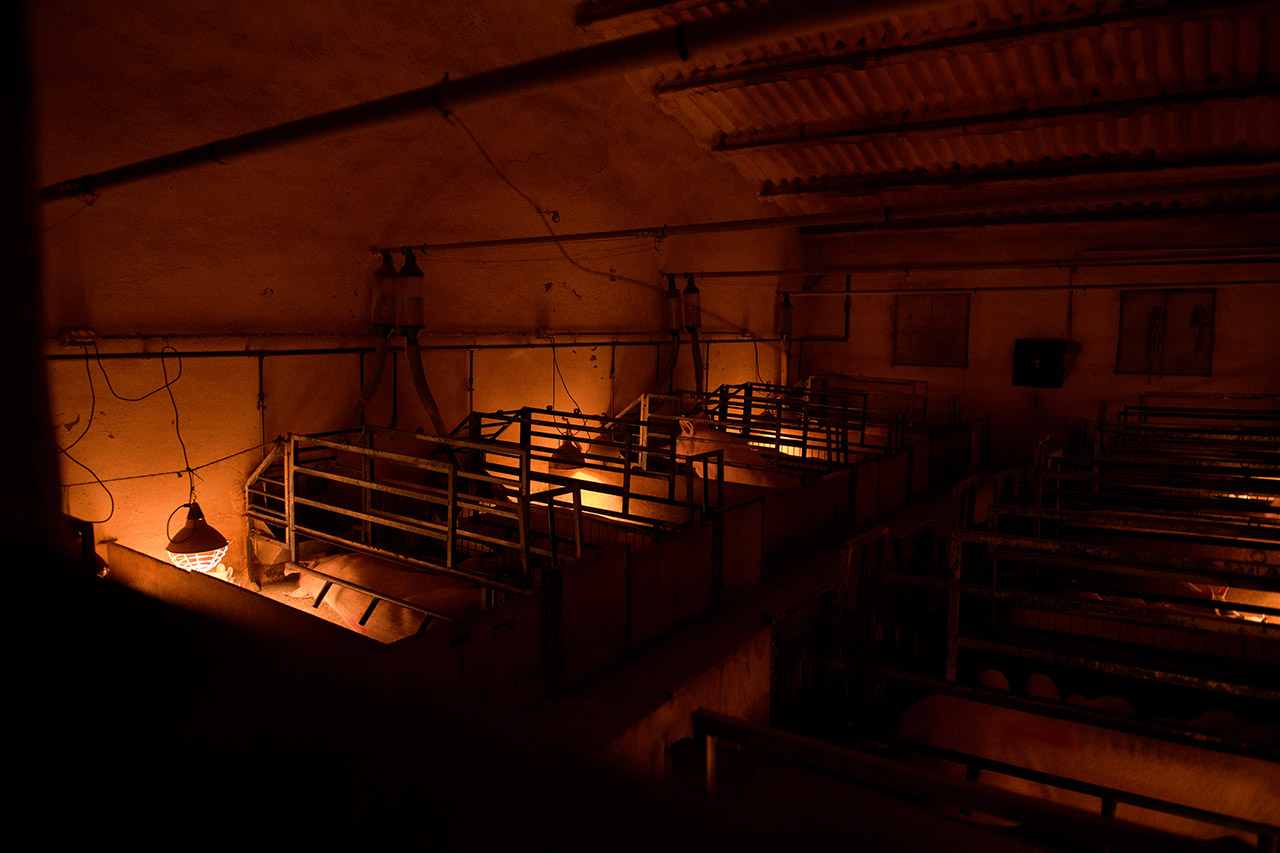
Maternity area, Castilla y León, 2020.
While there are differences between one farm and another, the images presented below, as well as the description of each phase, are representative of industry-wide standard practice in pig farming.
The investigation has been carried out without permission and in exercise of the right of access to information. The farms have been selected at random and the irregularities discovered correspond only to these farms, not to others. However, as long as the industry continues to prevent critical press access to its facilities and slaughterhouses, and given that the images and information obtained as part of this work demonstrate serious instances of suffering and neglect, it seems prudent to adopt a precautionary principle and assume that these standards are representative; leaving it for the industry itself to lift the veil of secrecy and prove otherwise if this is not the case.
The process of industrial pig farming begins in the gestation rooms, where sows are inseminated and kept in individual crates for intermittent periods of several weeks. These sheds contain no bedding material where the sows can rest comfortably. Instead, the flooring is hard concrete, with openings to allow feces and urine to be flushed out. These openings are not always effective, and excrement accumulates at the rear of the crates. In two of the gestation rooms to which we have accessed the slurry had overflowed and formed puddles under the crates.
The law does not limit the amount of time that sows can be kept in these crates, and only mandates specific periods when they must be group housed. This period includes «from four weeks after the service to one week before the expected time of farrowing.».34 Outside of this period, it is completely legal to keep sows —naturally social animals— in individual cages.
The first time a sow is inseminated, she will be around eight months old and the procedure will be carried out in the crate. If she falls pregnant, she will spend the next four weeks in that crate, as per the legal allowances mentioned above. If it is discovered, following an ultrasound, that she is not pregnant, she will be kept in the crate and inseminated again until the procedure is effective. Those sows deemed no longer productive can also be housed in the crates while they await transfer to the slaughterhouse.
One week before she is due to give birth, the sow is transferred to the farrowing crate, where she may remain for up to five more weeks. Just days after her piglets are weaned, she will be inseminated again. This cycle is repeated throughout the sow's productive life, until she is deemed no longer of use and sent to slaughter.
Measuring approximately two meters (6.5’) long and seventy centimeters (2’) wide, individual cages severely restrict the animals' movements and impede their natural behavior. They cannot turn around or interact with other sows and their bodies can exceed the width of the cages. Various studies carried out during the gestation period confirm a whole series of health problems associated with confinement in cages. When lying down, the body of the sow is pressed against the bars and their limbs, extended towards the adjacent cages due to lack of space, can become crushed. This spatial restriction has been identified as a cause of injuries and wounds that cause pain and suffering.35
Likewise, the sharp edges of the crate’s slatted floors injure their feet, and sows that are starved of food can suffer snout damage when trying to access the feeder in adjoining cages.35 Exercise deprivation negatively impacts cardiovascular health,36 muscle mass, and bone density37. Different stereotypies —obsessive, repetitive movements which are indicators of mental distress— have also been observed in many of them: biting bars, chewing despite their mouths being empty, pushing against the trough, head bobbing, repeatedly putting their snout in the gutter or rolling their tongue.30, 38, 39, 40, 41
Another factor affecting the health of the sows is poor hygiene. During the weeks they are confined, the feces accumulated in the cage can come into contact with the vulva. This has been identified as one of the main causes of urinary tract infections.30, 42 Rodents and flies are also a potential source of disease transmission.43 In most of the gestation sheds we have visited there were populations of rodents, flies, and cockroaches.
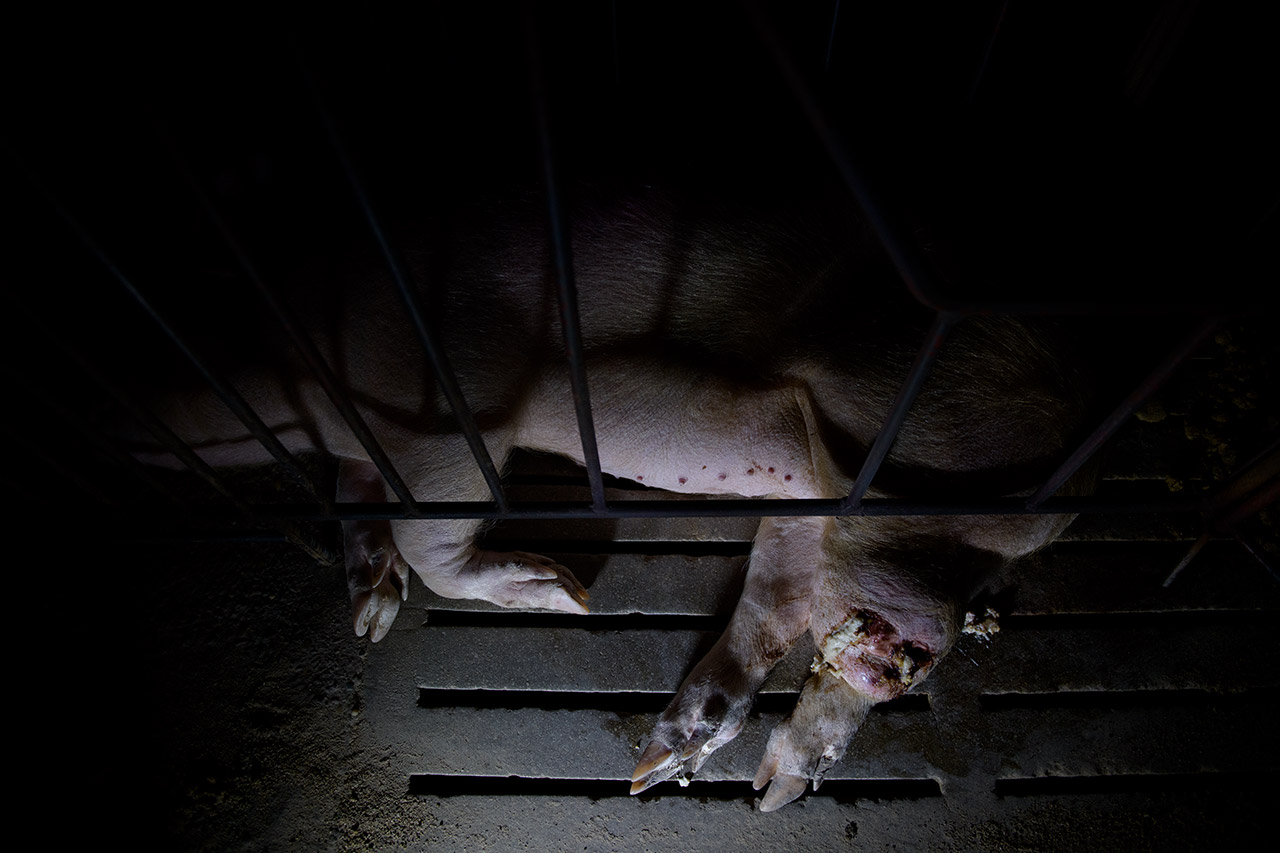
During the investigation we have found neglected animals suffering from several conditions that weren’t receiving any care. Aragón, 2019.
Group accommodation is not without its problems either. The natural tendency of sows to establish hierarchies is a behavior that occurs regardless of whether the animals are kept in confined systems or not. When they are in groups —mainly when new sows are introduced to the group— agression increases, often leading to younger animals being injured. In environments where food is scarce or limited, competition for food can also lead to fights. 44, 45, 46, 47, 48 The prevalence of lameness and hoof injuries is more frequent when sows are kept in groups.49, 50
According to data obtained through the PigCHAMP data management program, during 2007 the mortality rate of breeding sows in Spanish farms was 9.9%. In the report where these results are analyzed, associated causes of mortality —all of which have been evidenced before in scientific literature— include: high prolificacy, abdominal torsion and other abdominal conditions, heart failure, cystitis, problems related to the limbs and feet, pneumonia, ulcers, endometriosis and uterine prolapse. The report indicates that percentage of deaths increases and tends to double during the hot season.51
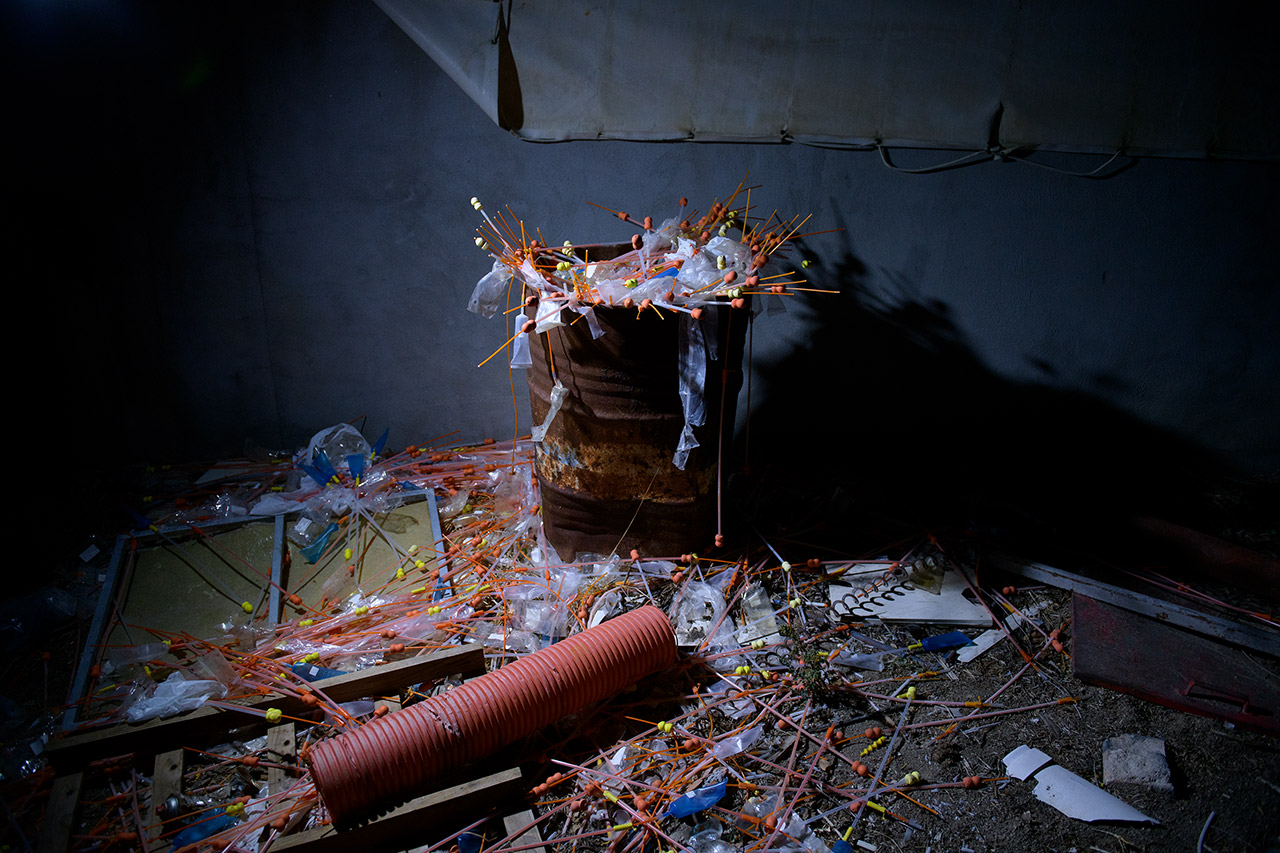
Artificial insemination utensils scattered on the floor at the entrance to the gestation shed. Castilla-La Mancha, 2019.
One week before giving birth, the sows are taken to the farrowing area, where the most delicate phase of production takes place. Due to this, the technical oversight and control is higher here than in other areas of the farm and the rooms are equipped with devices for more extensive control of temperature, humidity, and ventilation. In addition, each sow has a file that records the estimated date of farrowing (and subsequently the actual date), the number of piglets in gestation, and their current status.
The enclosures in the farrowing areas are modular and are comprised of a farrowing crate for each sow and an area for the piglets, from where they access their mother's udder. The floor is hard, made of metal or plastic, and has a grate system for the evacuation of excrement. Piglets require an ambient temperature higher than that of the sows and each enclosure has a heat lamp or underfloor heating to prevent hypothermia and thus achieve higher production levels. In some farms these lamps were broken and we found piglets shivering with cold.
The sows are kept in these cages until the end of their allowed lactation period, which ranges from 21 to 28 days. The farrowing crates are similar in size to the gestation crates and, likewise, restrict a large part of the animal’s movement, negatively affecting their health and preventing natural behavior.
The cage system is designed to avoid crushing of piglets by sows, a frequent cause of death. However, although the studies that exist show contradictory results, some confirm that the mortality rate in this type of cage and in «free-range» farming systems can be similar.52, 53, 54, 55 In any case, the concern shown by the industry on this matter is not to mitigate or prevent the suffering of piglets, but to maintain and increase production levels. When all other criteria are equal, a larger litter is more beneficial to the industry than a smaller one.
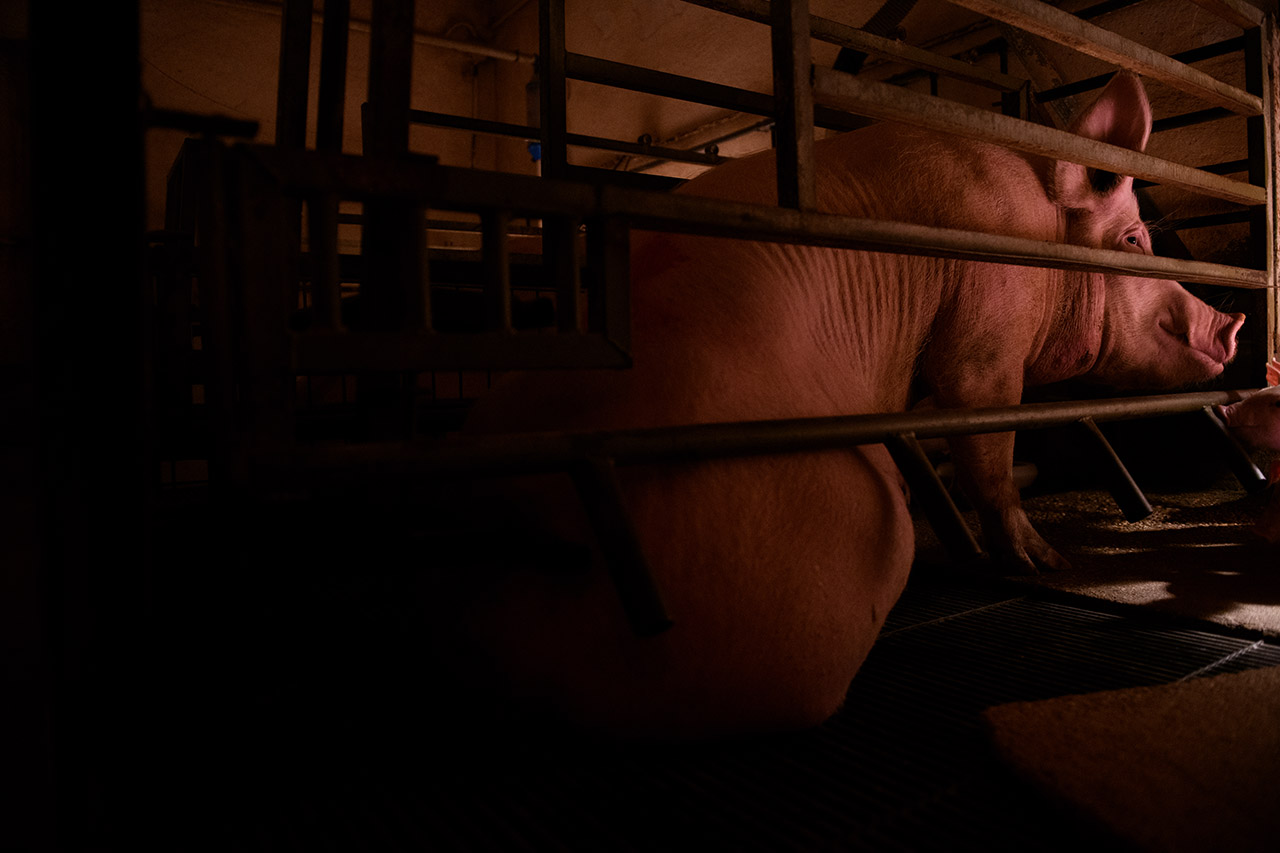
Farrowing crate where delivery and lactation take place. After a period that ranges between 21 and 28 days, the sow undergoes forced separation from her young. Castilla and Leon, 2020.
Piglet mortality during the lactation phase is high. The BDporc system places it at 19% (2019)27 and the Red Nacional de Granjas Típicas (RENGRATI) between 9% and 15% (2018).56 Recent advances in pig reproduction have led to the creation —via targeted selection programs to enhance prolificacy— of genetic lines of sows that produce higher numbers of piglets. Consequently, the health and life of the animals has been further compromised, and their mortality rate increased.57, 58, 59 One of the most common problems derived from large litters is unequal weight distribution of the piglets.60 Size difference presents particular problems for the smaller animals and gives them a lesser chance of survival. For example, they generally demonstrate lesser ability to thermoregulate, they find it difficult to compete for their mother’s milk, and they demonstrate poor physical coordination. These issues increase the probability that the smaller piglets will die from hypothermia, starvation or crushing. Furthermore, the prolonged labors associated with larger litters also increases the risk of intrauterine hypoxia (where the fetus is deprived of oxygen in the womb).60
Numerous studies have concluded that the intentional manipulation of genetic lines to create sows who produce large litters clearly has a negative impact on the health and welfare of the animals themselves. Despite this, the practice remains legal and within the parameters of regulatory frameworks for animal welfare.
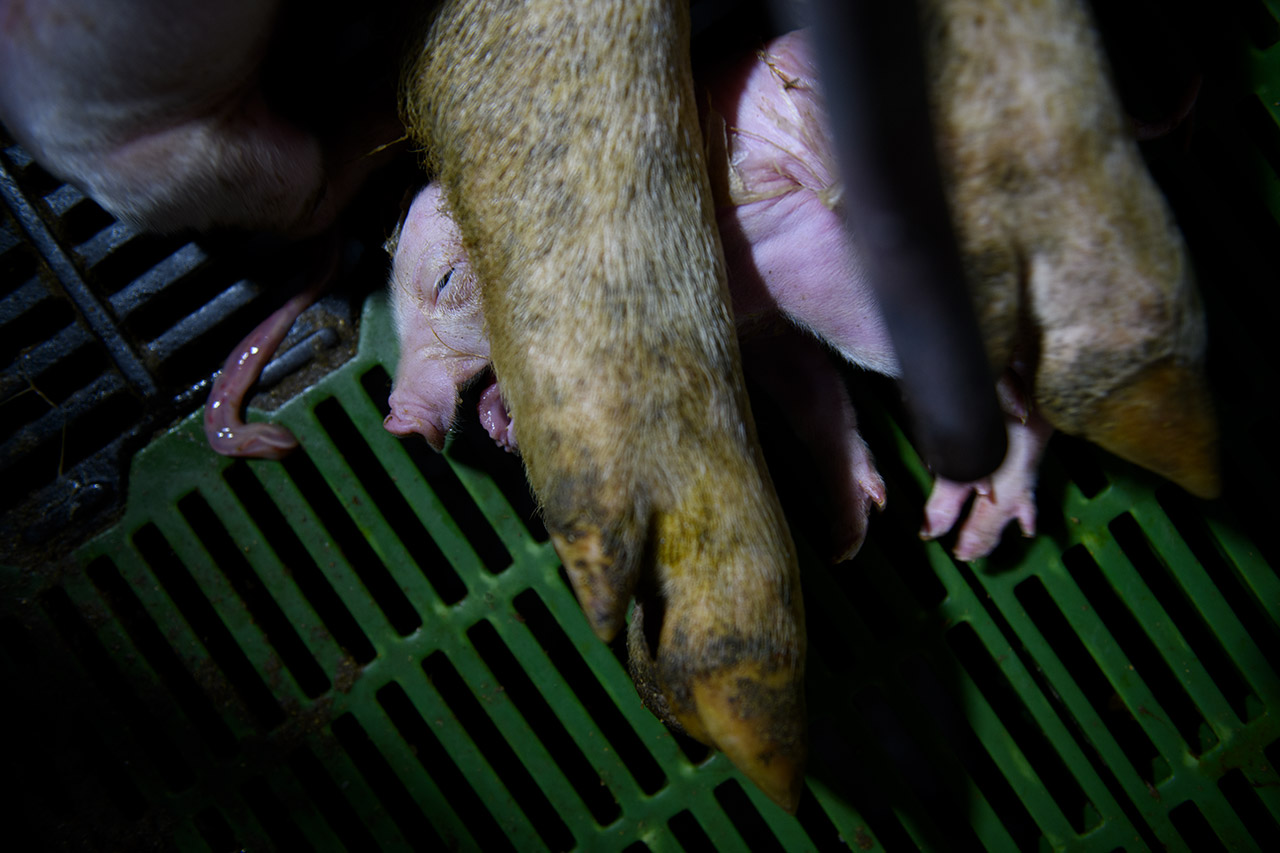
Crushing is one of the leading causes of death in piglets. Aragon, 2019.
The following section outlines some of the procedures which take place during the farrowing phase which compromise the physical and psychological wellbeing of the animals involved. These are standard procedures, used in a systemic manner across the entire pig farming industry, perfected and approved by veterinary entities and compatible with current animal welfare laws.
Weaning is one of the most critical life stages of the pigs. After being forcibly separated from their mothers, piglets are exposed to multiple stressors, the consequences of which can be lethal. They suffer an unexpected change of environment, a new feeding regime, and they share space with other animals with whom they must compete for food.61
An experiment carried out with a group of pigs revealed that, under conditions free from human intervention, domestic sows suckle their young for up to three months.62 In confinement systems, piglets are weaned abruptly, when they are separated from their mother and transferred to the transition area just 21 to 28 days after birth. It is performed prematurely, during a period where the mother would naturally be continuing to feed her young, and when there is still a strong bond between mother and piglets. In the time immediately after separation, the piglets make loud vocalizations. These responses are most common in those who have been weaned too early and may indicate distress over separation from their mother.63
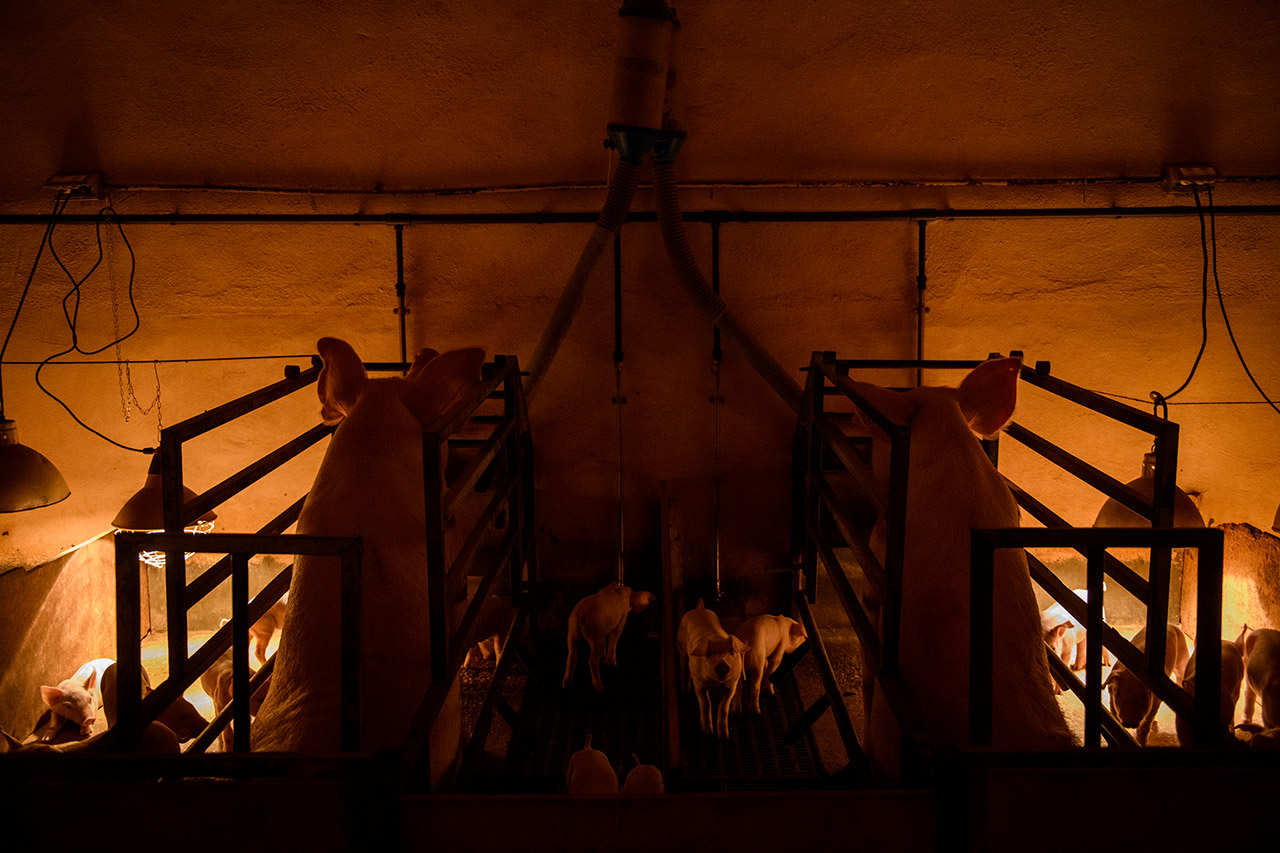
Crates in the maternity area. Castilla y León, 2020.
The European Union directive that establishes the minimum standards for the protection of pigs recognizes that castration, as well as tail docking, and partial cutting of the teeth are practices that are «harmful to the welfare of pigs, especially when executed by incompetent or inexperienced people».32
Despite the fact that the legislation itself identifies the aforementioned procedures as a cause of suffering, it not only permits them, but also allows them to be carried out without anesthesia in the first seven days of a piglet’s life.
Castration is carried out for two primary purposes: (i) to avoid the sex odor of the meat —which occurs in pigs when they reach maturity and which some consumers find unpleasant— and (ii) to reduce aggressiveness in the pig pens. Intact pigs —the term used to describe uncastrated males— are more efficient in terms of feed conversion but the most important European markets do not accept meat from these animals.64 According to a survey carried out by the European Federation of Veterinarians (FVE) and the Directorate General for Health and Food Safety of the European Commission (DG SANTE), 15% of male pigs in Spain were subject to surgical castration in 2015, with 61% of male pigs across the whole European Union being subjected to the same. Respectively, it was carried out without anesthesia in 91% and 95% of the cases.65 Castration has also been associated with higher mortality rates.66
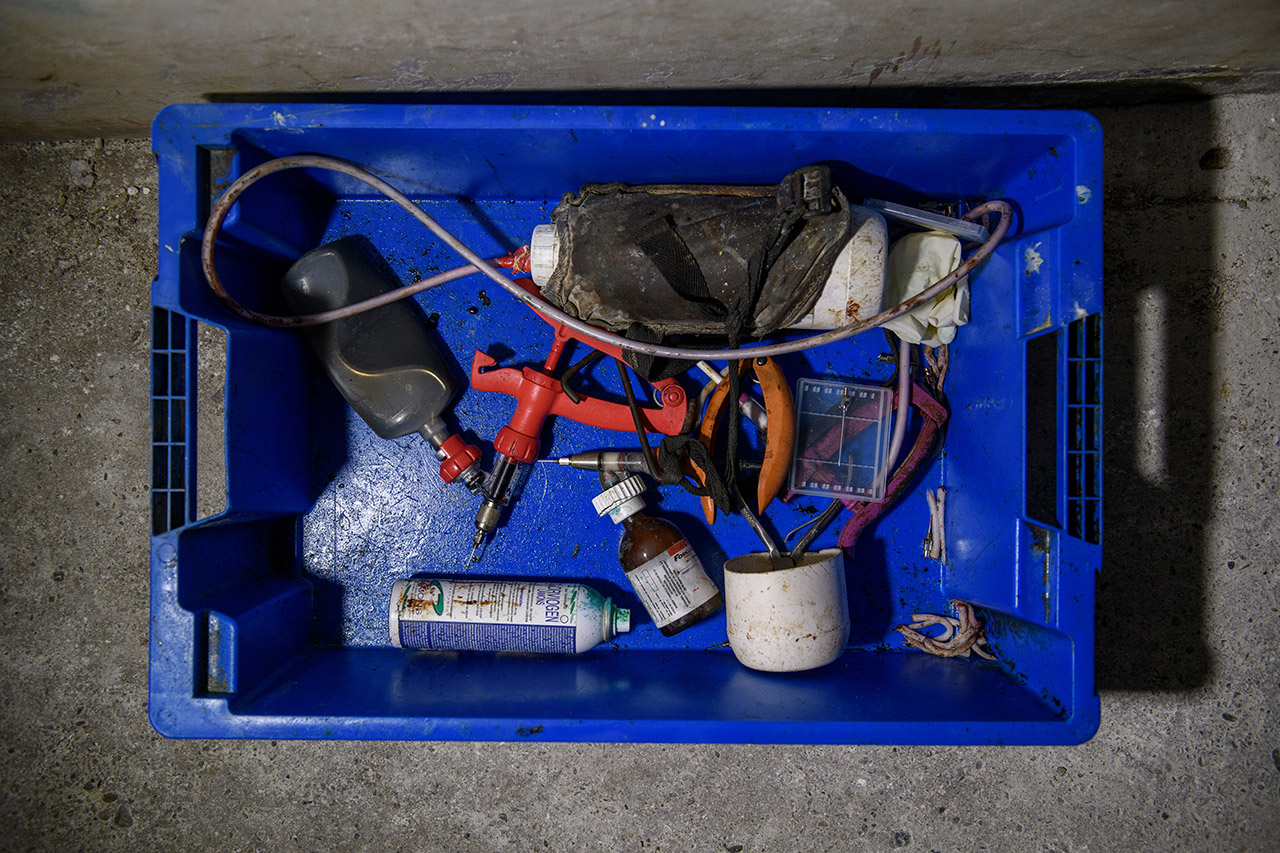
Commonly used implements in the maternity area. Amputated tails are seen in the lower right corner of the box. Aragon, 2019.
Caudophagia is an anomalous behavior of pigs biting one another and is known to occur when the appropriate environmental conditions are not provided for, such as within the systems of confinement adopted by industrial farms.67 One of the most widespread measures to deal with this behavior is tail docking. The procedure consists of the amputation of part of the tail and, according to various studies, causes acute pain and stress.68 Legislation prohibits it from being performed routinely, however, an audit by the European Commission carried out in Spain during 2017 found that an estimated 98.5% of pigs had been subjected to the procedure regardless. The report also concluded that the authorities have not adopted effective measures to prevent it.69
Another mutilation that piglets are subjected to shortly after birth is the cutting of their canine teeth; a measure that seeks to avoid biting injuries between piglets and damage to the mother’s udder. It is usually carried out with a pair of pliers, which are used to cut the tips of the teeth, or with an electric file to file them down.70 Files are used more rarely as this method is more expensive. As with tail docking, it is a procedure which can cause acute pain71 and its routine application is prohibited by law.
The law requires that pigs be identified with a tag or tattoo as a means of tracing them to the farm of origin.72 Tags are made up of two pieces which are joined together in a painful procedure73 which pierces the ear. The tattoo is made by punching holes in the skin with an inked awl, which is pressed into the skin using pliers.
The physical and psychological well-being of the piglets is compromised as a direct result of these procedures. Furthermore, piglets may be born on the accumulated feces of their mothers, while the crates prevent natural physical bonding between the piglets and their mothers. Large numbers of piglets die from hunger, thirst, disease, or crushing.
When piglets die, they are not always removed immediately. During our time documenting the farrowing areas, we saw corpses of pigs lying in corridors, accumulated in a corner, in plastic buckets, on wheelbarrows, and even inside the enclosures themselves, along with their living siblings. Some bodies showed signs of having been there for days or having been partially eaten, probably by cats or rodents.
In one of the farms we discovered a water leak. The affected sow had not been moved to a dry room and remained in these wet conditions overnight. In another, cats shared the enclosure with sows and piglets. On the ground we found bones, the remains of dismembered pigs and we also witnessed a cat eating a dead piglet.
After weaning, the piglets are moved to the transition area or loaded onto trucks to be transported to the slaughterhouse. They may otherwise be transferred to another farm where their fattening process is completed.
When they enter the transition area, they weigh between 6 and 8 kg (13 and 17.5 lb) and remain there for around 40 days.56 Later they are transferred to the fattening area weighing in at around 20 kg (44 lb). These figures correspond to average values and may vary depending on the production strategy, the end destination of the animals, or the genetic line in each farm.
The rooms in the transition area are organized one behind the other, along one or more corridors and are equipped with devices for temperature control and ventilation. The ground on which pigs sleep, rest, defecate and urinate is made of hard metal or plastic grating. The enclosures have feed hoppers that supply the feed automatically and push buttons from which the water is obtained.
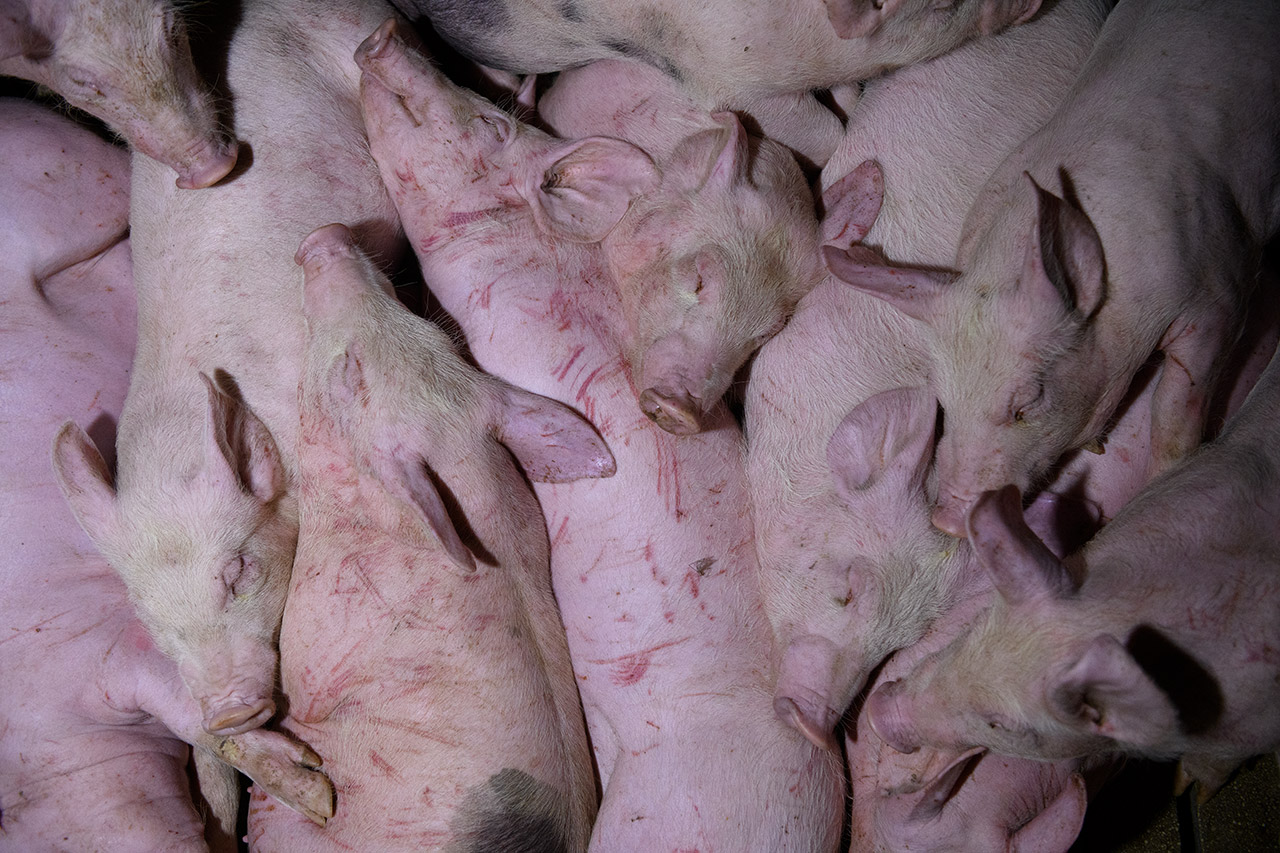
When piglets from different litters are mixed fights for establishing hierarchies within the group take place. Aggressions cause injuries and affect the welfare of the pigs. Castilla-La Mancha, 2020.
The diet they receive during this phase is administered through a feeding program aimed at developing the pig's full growth potential. This seeks to obtain the maximum performance level and the highest possible weight at the point of entry into the fattening process. It is a particularly delicate stage for production, because the negative impact caused by the abrupt change in diet —which would occur gradually outside of the exploitative situation of the farm— and the environment where the piglets grow74 can drastically influence the profitability of the business.75
One of the most stressful parts of the process is the mixing of pigs from different litters in the same enclosure. The establishment of a new social hierarchy —something which would have been firmly in place in the natal litter—76 is decided via aggressive interactions which compromise the welfare of the animals.77, 78 In addition, the lack of space and overcrowded conditions contributes to increased instances of aggression.79, 80, 81 Regulations demand that pigs weighing 20 kg (44 lb) must have a minimum surface area of 0.2 m2 (2.1 sq. ft.) each.2 This corresponds to a surface area less than four sheets of paper.
All these factors affect the health of pigs, their immune system and predispose them to new diseases.82 The bacteria Streptococcus suis and Haemophilus parasuis are among the most frequent causes of disease in weaned piglets.83, 84 These pathogens enter the farm through asymptomatic carriers. Once stabilized in the population, transmission occurs vertically, from mother to child, and later horizontally, between pigs outside the farrowing area.85, 86, 87, 88 Infections caused by both bacteria usually remain in their bodies without manifesting. However, the conditions that occur in intensive production systems help the development of different conditions and lesions.89, 90, 91, 92 The clinical signs associated with both infections are, among others, nervous disorders (meningitis), depression, anorexia, skin lesions, tremors, despondency, seizures, leg shaking, poor coordination, pneumonia, abscesses, or dyspnea. They can also lead to the death of the affected animal.93, 94
We found pigs that showed the symptoms outlined above (see multimedia report): leg shaking, seizures, tremors, emaciation, skin lesions and apparent weakness. In one of the enclosures, where the word meningitis had been written in chalk on the wall, a group of pigs exhibited several of these signs at the same time. In another enclosure, we found decomposed bodies that appear to have been eaten by other pigs.
In 2018, in Spain alone, more than one and a half million pigs died during this phase.56 As production increases, it is likely that this figure will increase.
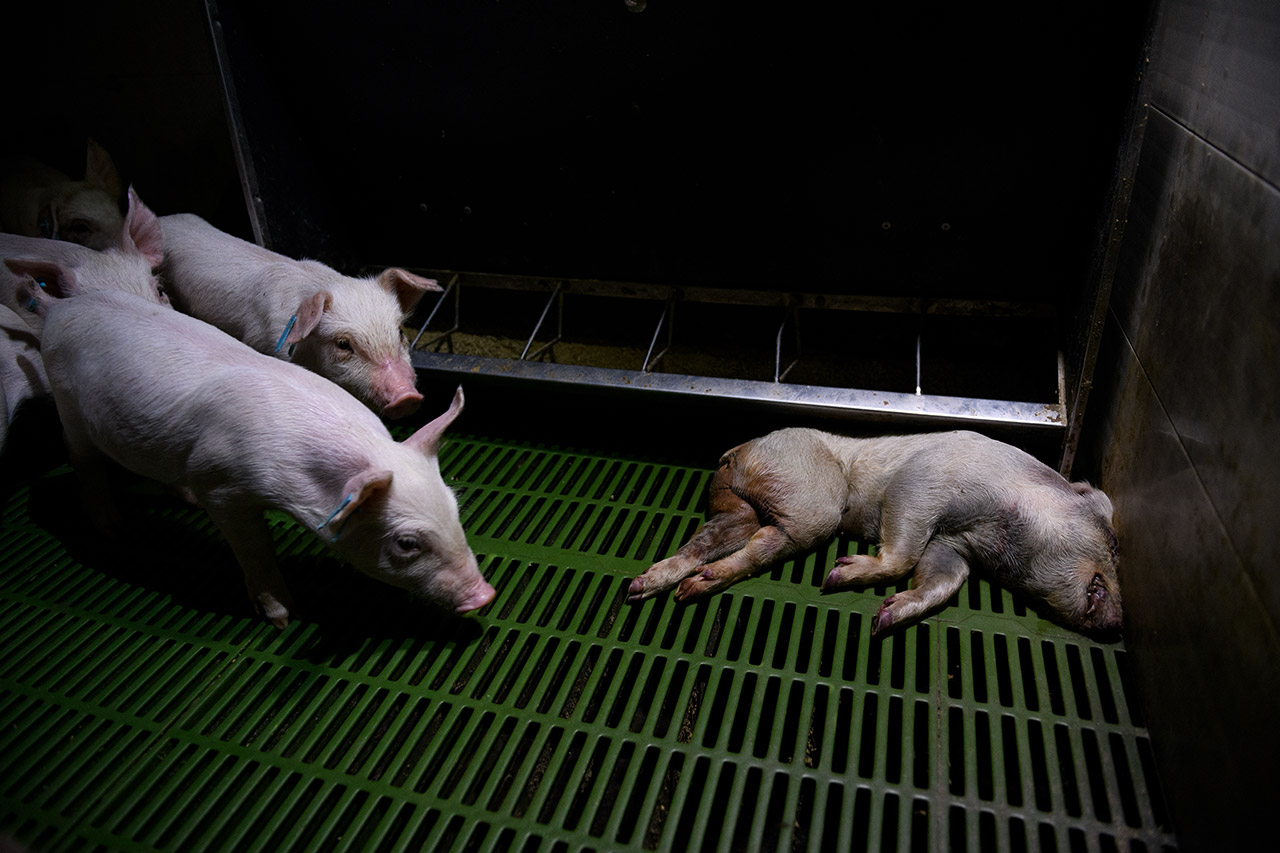
Weaned piglets in the transition area. This is the stage that precedes the fattening process. Aragón, 2019.
The last stage of the exploitation on the farm takes place in the fattening area, where the pigs remain for around 140 days until their final transfer to the slaughterhouse. They are usually housed in large sheds, whose interior is divided into rooms occupied by more than a dozen individuals. Ventilation is controlled by opening windows, unlike in the maternity or transition areas where it is regulated by more sophisticated devices. Temperature is an environmental factor that, when not controlled, will affect the well-being and health of pigs. The increase on temperature during the hot season can cause heat stress and even lead to death. The floor of the enclosures is made of hard concrete with a partially grated area under which the slurry accumulates. The only natural light the pigs receive is that which enters through the windows, which are usually dirty and semi-opaque.
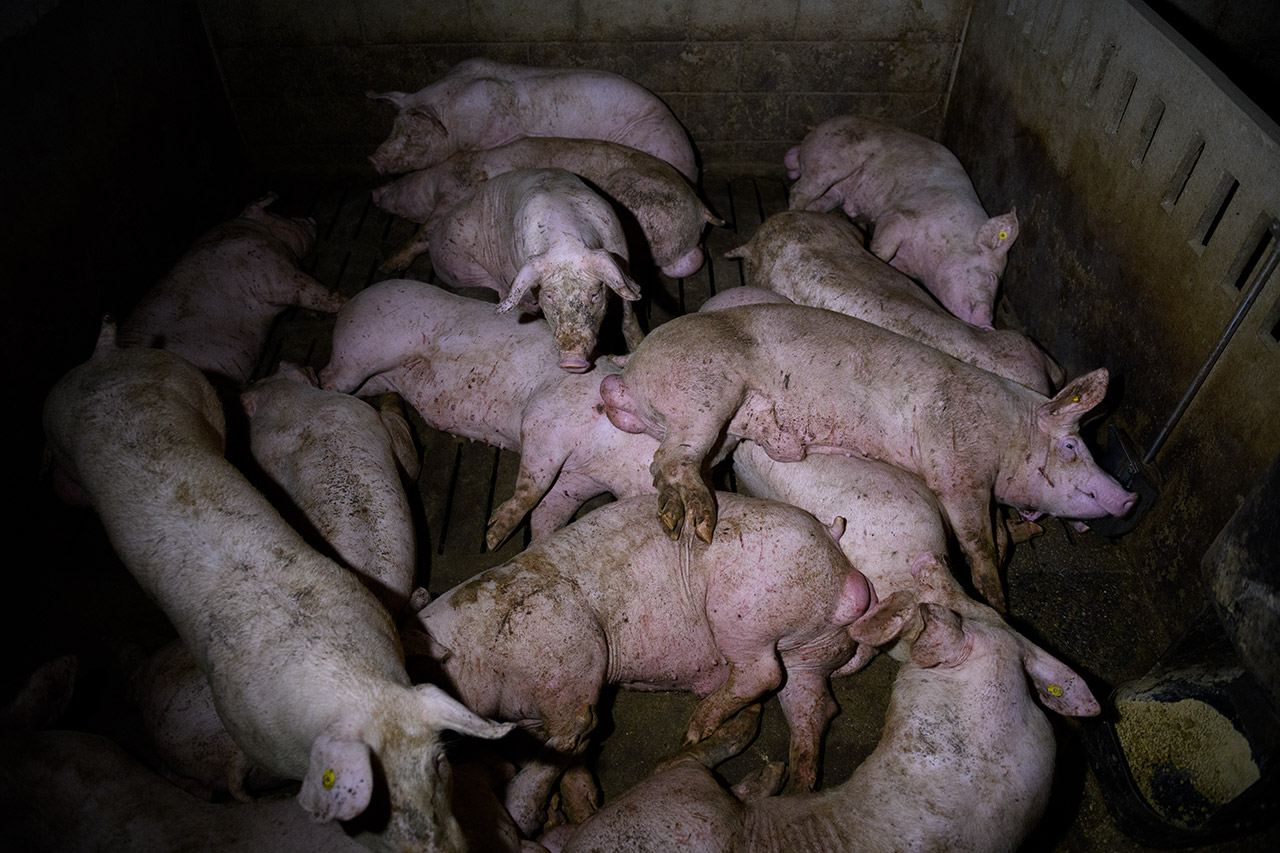
Enclosure in the fattening area. Aragón, 2019.
In the final weeks, when the pigs are close to their maximum weight, lack of hygiene and overcrowding reaches a critical state. The floor is covered with dirt, excrement and urine, the smell is overpowering and difficult to bear —even with mask— and it is common to find populations of cockroaches and rodents.
During their stay in the fattening area the pigs suffer from numerous health problems. Some of the most common ones found during the investigation are detailed below, but the following account does not represent an exhaustive list. We have also observed pigs with locomotion difficulties, with open wounds —some of them necrotic—, with infections exuding pus and with injuries caused by fighting. Others were in a state of agony and had been separated from the rest of the group, abandoned in corridors or corners until their death.
Inside the sheds, the pigs are exposed to a combination of gases and particles that, in high concentrations and for a prolonged period, result in damage to their respiratory system. Gases such as methane and ammonia —produced by the slurry accumulated in a pit under the floor of the enclosures—, different infectious agents, as well as dust from feed and dry fecal matter, have been associated with various lung conditions, such as pneumonia and pleurisy, as well as with higher mortality. 95, 96, 97, 98 JPorcine Respiratory Disease Complex (PRDC)99, 100 is a multifactorial disease caused by the aforementioned pathogens, other environmental elements, and differences in management practices and production systems. Due to its incidence in production and its subsequent economic impact on the industry, it is considered to be one of the major concerns for pig health today.101, 102
A study carried out in 39 Spanish fattening farms revealed that 71% of pigs suffered some type of lung disease.103 Another study that analyzed the ailments of more than 2 million pigs showed a similar figure: only 32 % of the pigs arrived at the slaughterhouse with healthy lungs.104
The most widely accepted hypothesis about the origin of tail biting among pigs (caudofagia) is that it is an abnormal form of exploratory behavior.105 Pigs spend a large part of their daily activity budget exploring their environment using their snouts; mainly to collect, carry and manipulate food.106 This behavior is also used as a way of obtaining novel information from the environment or simply to satisfy their curiosity.107 If they are deprived of the appropriate environmental conditions and their natural behavior is restricted, this exploratory behavior is redirected towards other stimuli, such as the tail of other pigs.
Caudophagia happens gradually. Initially, the animal tolerates the bite until injuries break the skin and cause bleeding. As the bites become more severe, the pig stops resisting the persistent biting and the resulting injuries can cause infections in the skin, vertebrae, and muscles.108 Various studies carried out in the EU indicate that the prevalence of tail injuries are in an average range that varies between 3% and 10%. However, the European Food Safety Authority (EFSA) warns that these studies have been carried out exclusively in slaughterhouses and that the prevalence on farms is likely to be even higher.109 In the most acute stages, tail-biting can lead to cannibalism. The blood attracts other pigs who then chase the injured animal in groups and devour their hind parts, which can result in the pig’s death.108, 110 Ears, flanks and limbs have also been documented as being cannibalized in farms.111, 112
Tail injuries —some of them serious— have been observed in the vast majority of fattening sheds. In one of the farms we were able to verify the presence of cannibalism during two separate visits. In addition to the remains of bones and rotten bodies, we documented a group of pigs devouring a corpse in an apparent state of decomposition.
Rectal prolapse consists of parts of the rectum being forced out through the anus due to increased abdominal pressure and a weakening of the sphincter and anal tissues. It is a painful and relatively common condition113 that can manifest at all ages, but its presence is more frequent in pigs between 6 and 20 weeks of age. Various factors that can influence its development have been pinpointed, such as infections, low temperatures, the density of animals per enclosure, genetics, or nutritional deficiencies. If the pig that suffers from this condition is not isolated, they may end up being cannibalized by the rest of the group.114, 115 A study carried out in a farm in Murcia found a prevalence of rectal prolapse of 4% and 8% in each house. Only half of the pigs recovered from this condition.116
Two of the most striking physical abnormalities that can affect the health of pigs are hernias and abscesses. These appear as lumps, mainly in the abdominal area, under the groin, or under the neck. Hernias occurs when a part of the intestine pushes out of the abdominal cavity but, unlike prolapse, remains under the skin. An abscess consists of a pus-filled cavity that contains dead cellular material and many bacteria. It originates with the entry of these microorganisms into the body through lesions on the skin or orifices. We found pigs with these swellings on all farms with a fattening area. Some were large and apparently serious, with open wounds caused by rubbing on the ground and coming into contact with excrement. The vast majority of affected animals had been isolated; however they did not appear to receive veterinary care.
Conjunctivitis is inflammation of the conjunctiva, a thin, delicate membrane that lines the eyeball and eyelids. Permanent exposure to microorganisms, poor ventilation, the presence of high concentrations of toxic gases, and excess dust have been described as potential causes.117, 118 Many pigs were suffering from eye conditions, some serious, in enclosures with infrastructural deficiencies and poor hygiene.
As already indicated, many pigs do not survive the extreme exploitation that is meted out to them. Others have injuries or illnesses that, for the purposes of profitability, it is not deemed financially viable to treat. They can also suffer from conditions that are considered a risk to other animals and production or to public health. If these circumstances occur, the pigs must be killed on the farm itself under the protocols required by law, which, as will be seen later, does not always happen.
The Ministry of Agriculture, Fisheries and Food (MAPA) has recently published a guide detailing the procedures to be applied when killing pigs and under what circumstances. It should be noted that in this guide the term euthanasia119 is used to refer to the killing of animals that could regain their health but who do not receive adequate veterinary treatment due to the lack of profitability associated with providing that care.
The killing procedures allowed by law are the following: captive bolt pistol and subsequent severing of the spinal cord or cutting of the throat; forceful blow to the head by means of a heavy object —examples are cited: hammer, truncheon or metal pipe— for pigs weighing less than 5kg; free projectile weapon, such as pistol, shotgun, rifle, or revolver; electric shock for pigs weighing more than 5kg; asphyxia by inhalation of gas in containers; or lethal injection. Except for the latter, which must be carried out by veterinary personnel, all procedures can be carried out by farm operators.
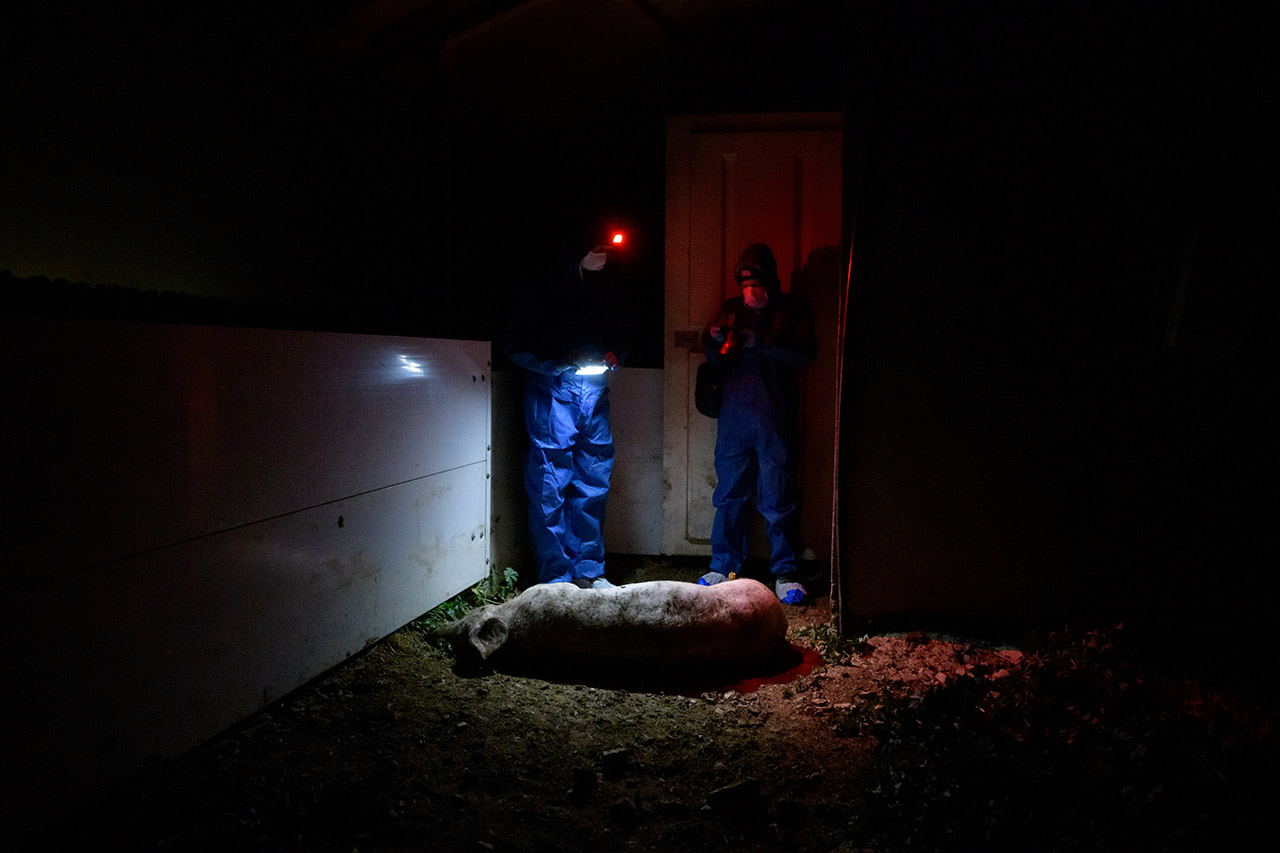
Exteriors of a fattening shed. Castilla La Mancha. 2020.
According to the latest figures provided by the Government, the number of animal welfare inspections carried out during 2017 was 11,195 out of a total of 364,430 livestock farms. Non-compliances were found in 19.38% of them.120 If these percentages are assumed to be representative of the total number of farms, the number of farms that did not comply with the regulations and were not inspected can be extrapolated to higher than 59,000. The quality of inspections that are carried out is insufficient, their duration is very limited, and they lack the ability to detect all irregularities.
In order to confirm whether the breaches observed during the investigation were isolated events or routine procedures, we entered some of the farms more than once. During the first visit to a fattening shed, we documented the presence of dead animals in different enclosures. Months later, during the second visit, the bodies were still in the same position. On both occasions we witnessed cannibalism, corpses in a state of decomposition, and remains of bones.
Another event that reveals the absence of institutional control and the impunity that livestock farms enjoy occurred months before starting this work, while I was conducting an investigation into slaughterhouses with Linas Korta. Taking advantage of the opportunity, we visited several farms that we saw from the road with the intention of documenting the handling of the animals. At the entrance to one of them was the corpse container, where the bodies of the animals that have died are thrown awaiting their collection and subsequent disposal. As we usually do in these cases, we lifted the cover. At the bottom, among the corpses and excrement, lay a trembling piglet, who was barely weeks old, clearly in a state of agony. He died hours later at the veterinary clinic we took him to.
It isn’t possible to know the specific number of pigs that suffer from these or other horrors, but the circumstances described give an idea of the institutional helplessness they are forced to endure.
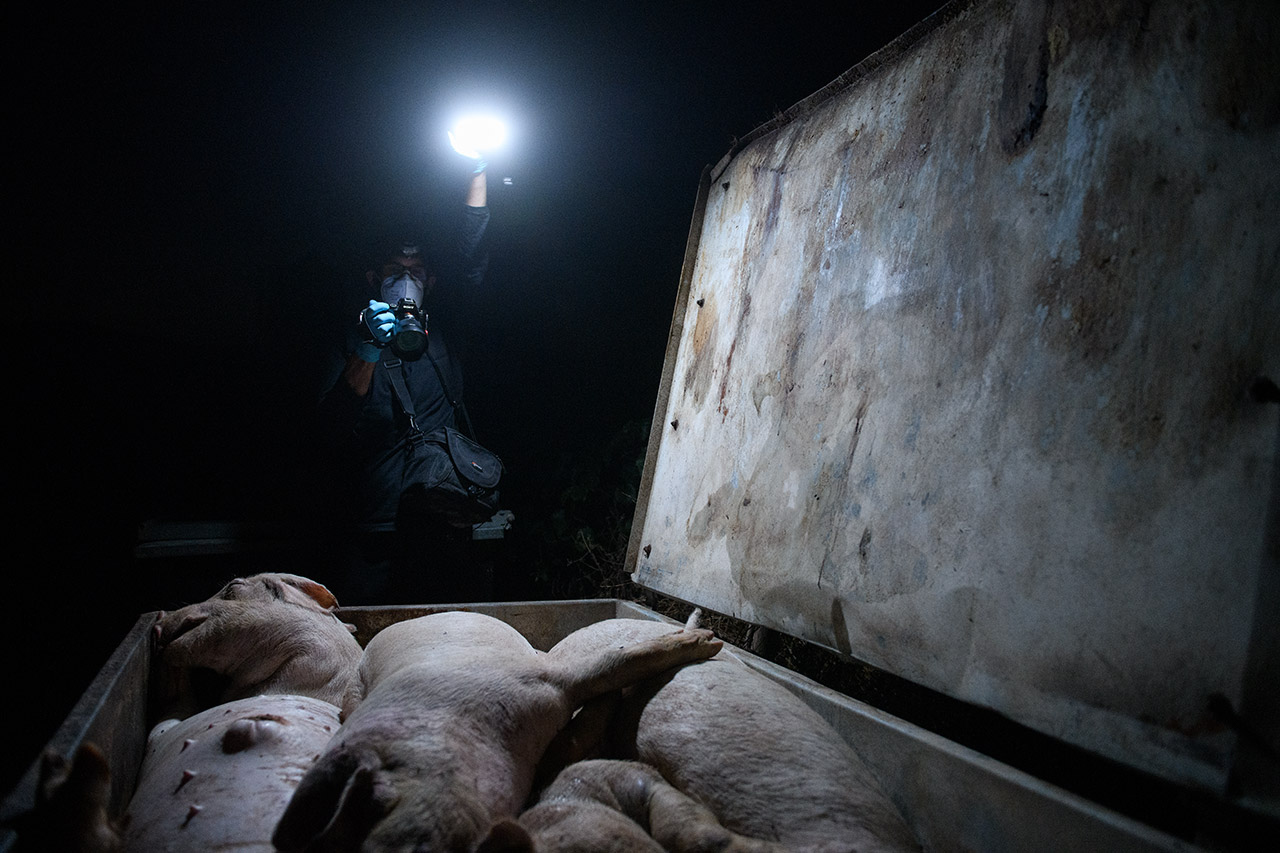
Container where the corpses of dead animals are thrown to, waiting to be taken and disposed of. Castilla-La Mancha, 2020.
There is a widespread and mistaken perception that animal welfare measures, if correctly applied, significantly prevent animal suffering. Consequently, when images of abuses perpetrated against animals come to light, the demand is that the administration must do better at implementing the law and meeting out punishment. This is because there is little understanding of what legal protections mean in practice. It is also convenient for consumers to trust that the laws are protecting animals as it helps to reduce their feelings of complicity.
Animal welfare laws, as currently written and structured, lack the power to protect animals. Indeed, they were neither conceived for this purpose nor does the production framework in which they are applied, as has been seen, permit for animals to be meaningfully protected. Since its inception, the purpose of the law has been to limit specific practices, but it was not designed to prevent or question the suffering inherent in the planned and systematic exploitation of animals. Therefore, it is not surprising that the European Union directive which establishes the minimum standards for the protection of pigs, allows forced weaning, genital mutilation and the confinement of sows in cages where they cannot even turn around;30 or that the guide for the euthanasia of animals in pig farms drawn up by MAPA allows for a sick piglet to be killed by hitting them with a metal pipe instead of providing them any kind of treatment. In fact, the guide recognizes that it is only «sometimes» that attempts are made to prevent death. Furthermore, in parallel to the evolution of these regulations, laboratories continue to develop genetic lines of animals with higher growth rates or prolificacy to the detriment of their welfare.121
None of the facts found during the investigation are foreign to the industry or public administrations, which act in collusion and understand the emerging social concern about the treatment that animals receive on farms and slaughterhouses. They know that certain trade-offs are unavoidable. Therefore they implement some changes, such as quality or ethical standards labelling, that is then used to pretend some kind of welfare or freedom for the animals, which in reality never has and never will exist.
According to the Eurobarometer on the Attitudes of Europeans Towards Animal Welfare, 94% of citizens consider that it is important to protect the welfare of farm animals and 64% state that they would like more information about the conditions in those found by animals exploited on farms.122 This work has been carried out in the exercise of the right of access to information in order to present evidence to inform the public debate against the shielding of the livestock industry and the lack of institutional transparency.
I will end with these words, taken from a livestock magazine published in the 1970s, which accurately describes the historical function assigned to animals destined to serve us as food: «Forget the pig is an animal. Treat him just like a machine in a factory».123
BIBLIOGRAPHY